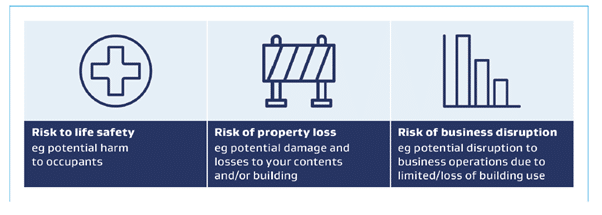The seismic performance of buildings is important for protecting lives; but it’s also important for reducing losses, continuing business operations, and protecting an organisation’s reputation and interests.
The Ministry of Business, Innovation and Employment (MBIE) has recently published the ‘Seismic Risk Resource for Commercial Building Tenants’ to give commercial building tenants more information on seismic risk and how they can make the best decisions for their business when considering leasing a building.
Property Council New Zealand is pleased to see the release of this document as time and time again, our members have told us that seismic issues are often front of mind for the industry. This is why early collaboration between central government and the private sector is critical to ensure that we are solution focused in creating a safer and more resilient built environment.
The Seismic Risk Resource for Commercial Building Tenants seeks to address these issues, specifically to help commercial building tenants understand their seismic risk tolerance and the seismic performance they require of buildings they either occupy or are considering leasing.
What do commercial building tenants need to know about seismic risk?
Seismic risk should be considered in the same way as other organisational risks, such as financial and reputational risks. The key difference is that seismic risk can be managed but not eliminated. Because earthquakes occur very infrequently, seismic risk management options should be evaluated with this low likelihood in mind, compared to more day-to-day organisational risks.
Tolerance for seismic risk should be considered from three perspectives: life safety, property loss and business disruption:

Building Code seismic performance requirements have a primary focus on protecting life safety, and so relying on these will not necessarily protect tenants from all these impacts in the event of an earthquake. The ‘percentage of New Building Standard’ (%NBS), the index used to characterise the expected seismic response of a building to earthquake shaking, is only designed to provide a relative assessment of seismic life safety risk, not potential damage or disruption to building use.
This seismic risk resource provides prompts and questions for tenants to ask themselves and others to better help them understand their tolerance for seismic risk, and the level of risk posed by their building. It also explains how to interpret seismic risk information and provides advice on actions they can take to manage seismic risk, including how to communicate with staff.
It also highlights the benefits of leasing a building with enhanced seismic performance (ie above current Building Code requirements). While these buildings may be more expensive to lease, doing so could reduce losses and costs, as well as improve competitive advantage after an earthquake.
The document was jointly prepared by MBIE, Resilient Organisations and the Joint Centre for Disaster Risk at Massey University, and co-funded by MBIE and the Building Research Association of New Zealand (BRANZ). It is part of a series of MBIE documents on seismic risk to support a better understand of seismic assessments, following on from the Seismic Risk Guidance for Buildings published in 2022.
Download the Guidance
The Seismic Risk Resource for Commercial Building Tenants is now available via the Building Performance website.
Download NowContact
Sandamali Ambepitiya
For further information please contact Senior Advocacy Advisor, Sandamali Ambepitiya.


